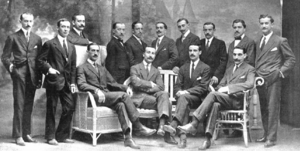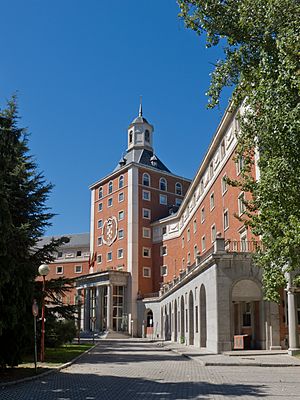Complutense University of Madrid facts for kids
|
Universidad Complutense de Madrid (Spanish)
|
|
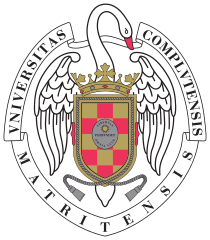 |
|
|
Former name
|
Estudio de Escuelas Generales de Alcalá (1293–1499) Universitas Complutensis (1499–1836) Literary University (1836–1851) Universidad Central (1851–1943) Universidad de Madrid (1943–1970) |
|---|---|
| Motto | Libertas Perfundet Omnia Luce (Latin) |
|
Motto in English
|
"Freedom will flood all things with light" |
| Type | Public research non-profit coeducational higher education institution |
| Established | 20 May 1293 |
| Founder | Cardinal Francisco Jiménez de Cisneros |
|
Academic affiliations
|
Compostela Group of Universities Europaeum IAU Una Europa UNICA Utrecht Network |
| Budget | €607,559,030 |
| Rector | Joaquín Goyache Goñi |
|
Administrative staff
|
11,162 |
| Undergraduates | 74,771 |
| Postgraduates | 11,388 |
| Location |
,
Spain
40°26′57″N 3°43′41″W |
| Campus | Urban 2 campuses in Madrid --Moncloa Campus --Somosaguas Campus |
| Colours | Red |
The Complutense University of Madrid (UCM) is a large public university in Madrid, Spain. It is one of the oldest universities in the world that is still open today. It started in 1293 in a town called Alcalá and later moved to Madrid in 1836.
The university is known as one of Spain's best places for higher education. It has a huge campus that covers a big part of Madrid's University City area. There are also other parts of the campus in a nearby town called Pozuelo de Alarcón. The university's name, Complutense, comes from the old Roman name for Alcalá, which was Complutum.
More than 86,000 students attend the Complutense University. This makes it one of the largest universities in Europe that doesn't focus on online learning. In 1857, it became the first and only university in Spain allowed to give out doctorate degrees. These are the highest degrees you can get. In 1909, it was also one of the first universities in the world to give a doctorate degree to a woman.
Contents
History of the University
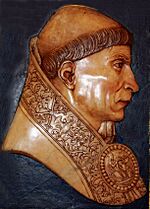
The Complutense University began on May 20, 1293. King Sancho IV of Castile allowed the Archbishop of Toledo to start a school called El Estudio de Escuelas Generales in Alcalá de Henares. At that time, universities were often called studium generale.
One of the students from this early school was Cardinal Cisneros. He bought a lot of land and built many new buildings. This became one of the first university campuses ever built from scratch. In 1499, Cardinal Cisneros got special permission from the Pope to make Complutense a full university. This meant that degrees from the university were recognized everywhere. The school was then officially named Universitas Complutensis, using the Latin name for Alcalá.
By the school year 1509–1510, Complutense University had five main schools. These included Arts and Philosophy, Theology, Law, Languages, and Medicine. During the 1500s and 1600s, Complutense became one of the best universities in the world. Many important scientists, artists, and politicians studied or taught there.
In 1785, Complutense was one of the first universities to give a doctorate degree to a female student, María Isidra de Guzmán y de la Cerda. This was much earlier than many other famous universities around the world.
In 1836, the university moved from Alcalá to Madrid. It was first called Literary University, and then in 1851, it became the Central University.
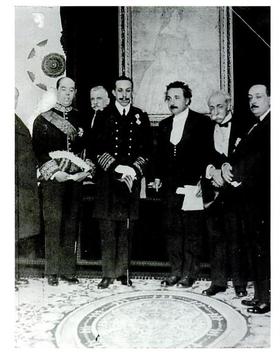
The Central University gave Albert Einstein an honorary Doctor of Science degree in 1923. This was the first honorary science degree he accepted from a European university. In 1933, Einstein even agreed to lead a research institute at the university. However, because of political problems in Europe, he decided to go to a similar place in the United States instead.
The university grew a lot in the 1800s. Its buildings in central Madrid became too small. The university used old mansions and palaces, which were not ideal for teaching. This changed in 1927 when King Alfonso XIII gave land near the Palace of La Moncloa to the university. This large area in western Madrid is now called the "University City."
A group chosen by King Alfonso XIII decided that the new University of Madrid needed modern buildings. They visited many famous universities in Europe and North America to get ideas. The buildings built during this time were designed to be useful and modern.
In the 1970s, the University of Madrid was renamed. Its different schools were divided between the Complutense University of Madrid and the Technical University of Madrid. When Alcalá de Henares opened its own university in the old campus buildings, it was named Universidad de Alcalá de Henares to avoid confusion.
Complutense Today
The Complutense University has been very important in Spain's history. Many of its graduates have become important leaders in the Spanish government. The university has also welcomed many famous thinkers and scholars from around the world, including Albert Einstein. During the 1930s, many European thinkers came to study here to escape problems in their own countries. Many Nobel Laureates have also studied or taught at Complutense.
Today, Complutense University is the largest university in Spain. In the 2004–2005 school year, it had over 91,000 students and about 9,500 staff members. More than 6,000 of these staff members are teachers. The university gets money from the government, grants, and student fees.
The university offers nearly 80 different main subjects and many different degrees. It has over 30 libraries with more than 2 million books. It also has a huge collection of historical documents and one of the largest film collections in Europe.
Because of its long history in Madrid, the Complutense University gets a lot of support from local and national groups. For example, its School of Medicine works with several hospitals in Madrid. The university also has close ties with the Spanish government. The official home of the Spanish Prime Minister and the Spanish Constitutional Court are both located on the university campus.
The School of Communications also has good relationships with the media. Many of its professors used to be reporters or editors for major newspapers. This school is also known for showing new Spanish films to students before they are released. The main actors or producers often come to talk about the films afterward.
The Faculty of Fine Arts started in 1978. It offers degrees in Fine Arts, Design, and how to preserve and restore old artworks. Many famous people have given talks at the university, from singers to writers and historians. The famous film director Alejandro Amenábar wrote his first movie, Tesis, while he was a student at Complutense. The movie was even filmed in the School of Communications building.
Student Life and Activities
The Complutense University has its own newspaper, the Gaceta Complutense, which comes out twice a month. It also has a radio station, Radio Complutense (107.5 FM), which broadcasts for 12 hours every day. Both are run from the School of Communications.
While the university has some dorms, most students live in apartments or other private housing. This is because university housing is not required and can be expensive.
The University of Madrid has over 100 student groups for politics, social activities, and sports. Students can take classes in aerobics, yoga, swimming, tennis, and many other activities. For team sports, there are basketball, football, volleyball, and rugby teams for both boys and girls. There are also teams for chess, badminton, golf, judo, karate, table-tennis, and archery. The different schools within the university compete against each other several times a year. The university also takes part in regional and national sports competitions.
Complutense Around the World
The Complutense University of Madrid has agreements with many universities worldwide. These agreements allow students and professors to study or teach abroad. Complutense also has four full-time institutions outside of Spain.
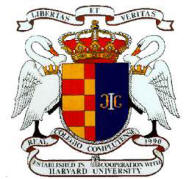
- The Real Colegio Complutense at Harvard University (Cambridge, Massachusetts): This special center was created to help Harvard University and Complutense University work together. It allows some Complutense professors to do research at Harvard. These professors have the same benefits as Harvard's own faculty. The center also helps a small number of students get their doctorate degrees at Harvard with scholarships.
- Collège des Hautes Études Européennes Miguel Servet (Paris, France): This center is located at La Sorbonne in Paris. It offers special degrees and programs focused on law and economy within the European Union. It also has a double-major program in French and Spanish law.
- Cátedra Complutense en la Universidad de Karlova (Prague, Czech Republic): This is a full campus that works with Charles University in Prague. It offers bachelor's and doctorate degrees.
- Cátedra Dubcek (Bratislava, Slovakia): This is another full campus that works with Comenius University in Bratislava. It also offers bachelor's and doctorate degrees.
University Rankings
| University rankings | |
|---|---|
| Global – Overall | |
| ARWU World | 301–400 (2023) |
| QS World | =187 (2026) |
| THE World | 501–600 (2024) |
| USNWR Global | =337 (2023) |
The Complutense University of Madrid is highly rated in international rankings. In the Shanghai Ranking, it is among the top 300 universities worldwide and among the top 3 in Spain. The QS World University Ranking places it as #187 globally, #58 in Europe, and #1 in Spain. The Scimago institution rankings show it as #175 worldwide. Overall, it is in the top 3% of universities globally.
Famous People from Complutense
Many famous people have studied or taught at Complutense University.
Notable Faculty
- Juan Luis Arsuaga (born 1954), a professor who studies ancient life forms (paleontology).
- Fernando Savater (born 1947), a professor who teaches about right and wrong (ethics).
- María Vallet-Regí (born 1946), a professor who works with smart materials for medicine.
- Alicia Gómez Montano (born 1955), a journalism professor.
Famous Alumni
Over the years, many Complutense graduates have become very successful. These include:
- 7 winners of the Nobel Prize.
- 18 winners of the Prince of Asturias Awards, which are important awards in Spain.
- 7 winners of the Miguel de Cervantes Prize for Spanish-language literature.
- Many prime ministers of Spain and other important leaders in Europe.
- Members of the Spanish royal family.
- Famous thinkers like José Ortega y Gasset and Ignatius of Loyola.
- Writers like Federico García Lorca and Pedro Calderón de la Barca.
- Scientists like Santiago Ramón y Cajal and Severo Ochoa.
See also
 In Spanish: Universidad Complutense de Madrid para niños
In Spanish: Universidad Complutense de Madrid para niños
- University of Alcalá
- Complutensian Polyglot Bible


